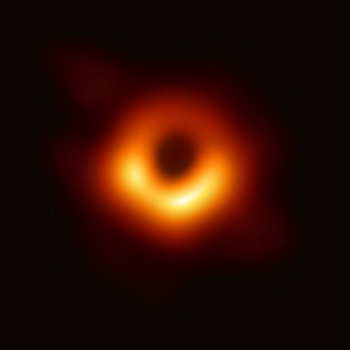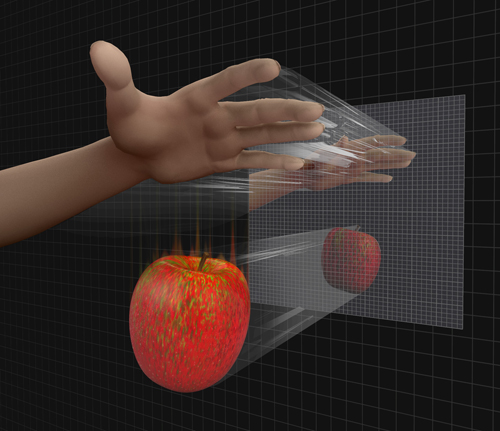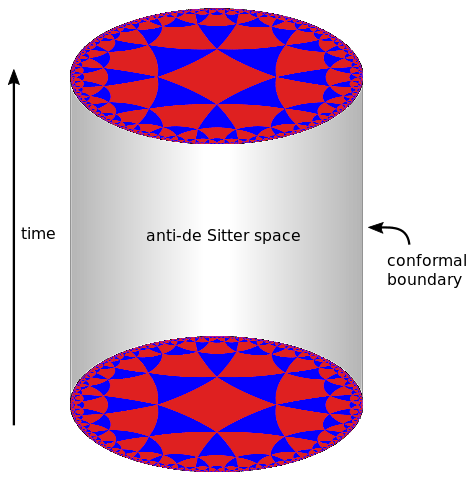Brief summary
The holographic principle says that the reality we experience, including the force of gravity, is just a hologram of some lower-dimensional reality. This strange idea arose as a possible approach to understanding quantum gravity – one of the biggest unsolved problems in physics.
Over the last three decades physicists have been developing a curious idea – the holographic principle. Perhaps the world we inhabit, including ourselves, is nothing more than an illusion, a hologram conjured up by a reality which lacks a crucial feature of the world as we perceive it: the third dimension.
This idea sounds like something you'd find in the far reaches of science fiction. But instead it has emerged as an important approach to the biggest problem in modern physics – quantum gravity.
The problem of quantum gravity
We have two fundamental theories of physics: Einstein's theory of gravity (known as the general theory of relativity) describes physics at the very largest scales of planets and galaxies, while quantum mechanics looks at the sub-atomic scales of the fundamental particles that make up matter. Both these theories are extraordinarily successful in their corresponding realms of the very large or the very small. But the problem is when they meet – in black holes.

Gravity is the manifestation of the curvature of space and time. Image courtesy NASA.
Black holes are formed when a large amount of mass is concentrated in a tiny region of space. The resulting gravitational pull is so strong that nothing can escape from a black hole, not even light, so there's no way you can ignore gravity when thinking about black holes. The small scale means that quantum effects also come into play. To describe what's going on in a black hole, you really do need a unified theory of quantum gravity.

They were first discovered mathematically as solutions to Einstein's equations of general relativity, but they have since been observed in our Universe.This is the first image of a black hole that was ever taken, released in 2019. Image: European Southern Observatory., CC BY 4.0.
One approach to understanding quantum gravity, which de Mello Koch from Huzhou University (China) and University of the Witwatersrand (South Africa) is pursuing with his colleagues, is to try to describe black holes using statistical mechanics. Black holes emerged from Einstein's equations of general relativity, that describe physics at the largest scales. Statistical mechanics takes into account the physics happening at a microscopic scale. (You can read more about statistical mechanics in our first article – From steam engines to the limits of physics.)
An example of this microscopic approach comes from the concept of entropy – a measure of the amount of disorder that is possible in a physical system. We saw in the previous article that the more configurations of the smallest components in your system that are possible, the higher the entropy of your system at some given macrostate.
Statistical mechanics said that entropy grows with the size of a system, that it is proportional to volume in our three-dimensional world. This is quite intuitive – the larger a system is, the more microscopic configurations that could come into play. But the entropy of a black hole doesn't behave in this way. The entropy doesn't grow with the black hole's volume, instead it is proportional to the surface area of the black hole. (You can read more about entropy and the paradox of black hole entropy in the previous article.)
The holographic principle
To unravel this paradox of black hole entropy an entirely new idea was developed: the holographic principle. Leonard Susskind, one of the first to precisely define the holographic principle in the 1990s, gave the following description: “The three-dimensional world of ordinary experience––the universe filled with galaxies, stars, planets, houses, boulders, and people––is a hologram, an image of reality coded on a distant two-dimensional surface."
If the holographic principle is true, then our three-dimensional approach to physics overshoots the mark. We should be able to get by with a leaner version, one that hinges on area, rather than volume. This raises the mind-numbing question of whether the third dimension is actually real, or merely an illusion, like the three-dimensional image created in a hologram.
"By anyone's standards the holographic principle is bizarre, so you shouldn't just accept it," said de Mello Koch in his talk at the Isaac Newton Institute for Mathematical Sciences. "That sounds fantastic – and fantastic claims require fantastic evidence. And in fact we have a very concrete setting in which the holographic principle is realised."
A holographic universe

A holographic universe.
Following on from work by Susskind and others, in 1997, at the tender age of 29, the physicist Juan Maldacena came up with the first ever concrete description of a holographic universe.
Maldacena's universe is not like the one we actually live in: it's a model, a toy universe, which comes complete with its own physics. It's a hologram because all the physical goings-on inside it can be described by a physical theory that's only defined on the boundary.
This boundary theory is a well-understood quantum theory of particle physics, very similar to the one we use to describe sub-atomic processes in nature. Referring only to small scales, it doesn't bother with gravity.
But despite gravity playing no part on the boundary of our universe, a being living in the interior will still experience gravity. Gravity in this universe is part of the holographic illusion. The boundary theory which defines this universe is able to describe the esoteric quantum gravity theory which governs the interior. It's the first ever complete description of a quantum spacetime.
A can of soup
The toy universe used by Maldacena is known as anti de Sitter space, after the Dutch physicist Willem de Sitter. (You can find out more about it in the article, The illusory Universe.) Anti de Sitter space is very different from the world we actually live in. "Our world is four dimensional and has a positive cosmological constant. Anti de Sitter space has a negative cosmological constant," said de Mello Koch. "While learning about gravity in this setting might be very interesting it may have limited applicability to understanding gravity in our Universe."But what is interesting is that Maldacena's model is a concrete realisation of the holographic principle: "The fact that a five-dimensional theory of gravity is being described in terms of a four-dimensional non-gravitational theory."
To make Maldacena's holographic Universe easier to picture, de Mello Koch suggests thinking of it as a can of soup. "We would really want a five-dimensional can of soup, but we are just going to think about a three-dimensional can of soup. But apart from that it's a good description!"

Is it Maldacena's holographic universe, or is it a can of soup? (Image adapted from one by Maky – CC BY-SA 3.0
The vertical direction in our can is time, and you can imagine taking time slices from the can. The slice at the bottom of the can is the initial time slice in our universe, while the slice at the very top of the can is the final time slice.
"Now where the label sits on the edge of the can of soup, that 's where the non-gravitational theory sits," said de Mello Koch. "And inside the can is where the [matter] is sitting – [that’s] the gravitational theory." Maldacena's theory (known as the AdS/CFT correspondence) said that any question that you want to ask about the inside of the can of soup, can be answered using just the lower dimensional theory on the label.
Although Maldacena's AdS/CFT correspondence has dominated the field since it was discovered 25 years ago, physicists still don't have a good understanding of how the holographic principle is working. "I would say it's still quite mysterious," said de Mello Koch. But there is extremely compelling evidence in favour of this duality.
"The holographic principle is a profound new principle of nature. It's incredible that gravity and spacetime are actually holograms of some lower dimensional non-gravitational theory." De Mello Koch's talk was part of a research programme hosted by the INI to bring together mathematicians and physicists to explore ideas such as the holographic principle, to advance our understanding of black holes and quantum gravity. "This really is a fascinating area of exploration and there are many many open questions left." We look forward to hearing more from de Mello Koch and his colleagues as they make progress.
About this article
This article is partly based our article The holographic principle based on an interview with Juan Maldacena, and on Robert de Mello Koch's Rothschild Lecture, part of the research programme Black holes: bridges between number theory and holographic quantum information at the INI in October 2023. You can read more about this programme here.
This content was produced as part of our collaboration with the Isaac Newton Institute for Mathematical Sciences (INI) – you can find all the content from the collaboration here.
The INI is an international research centre and our neighbour here on the University of Cambridge's maths campus. It attracts leading mathematical scientists from all over the world, and is open to all. Visit www.newton.ac.uk to find out more.
